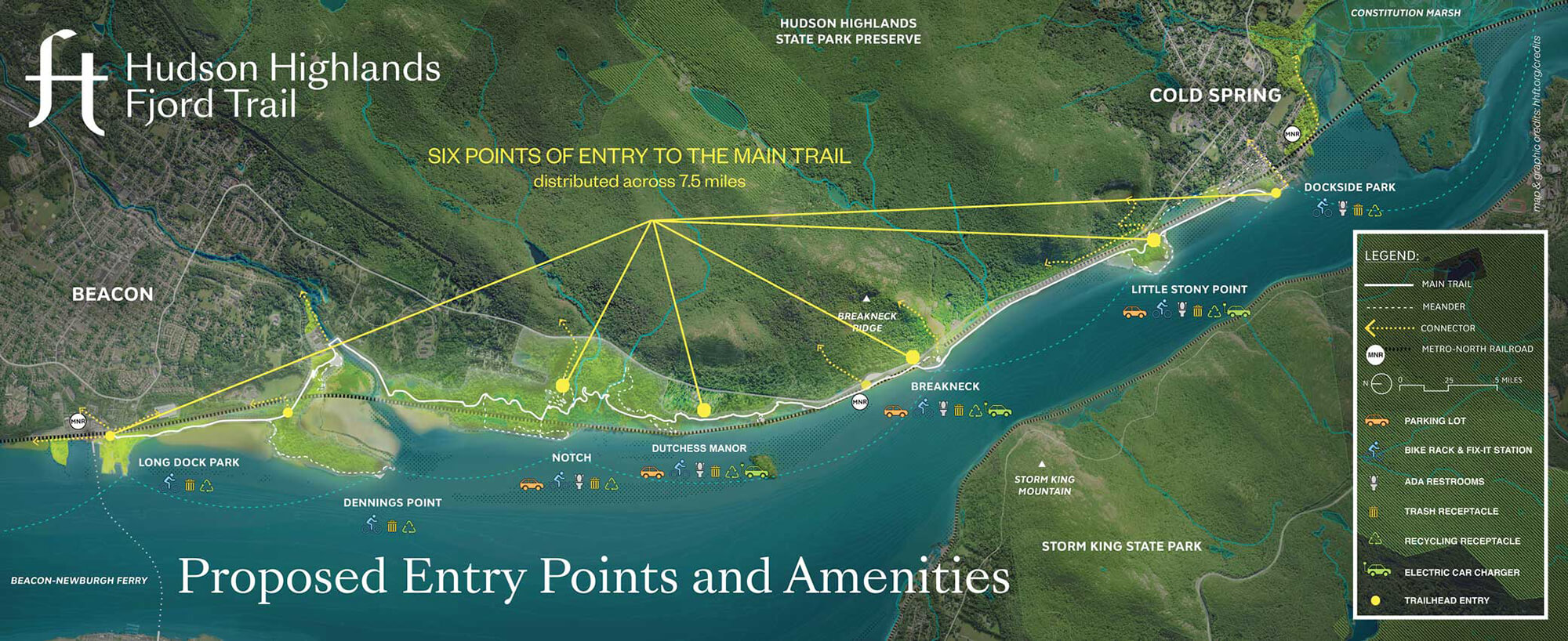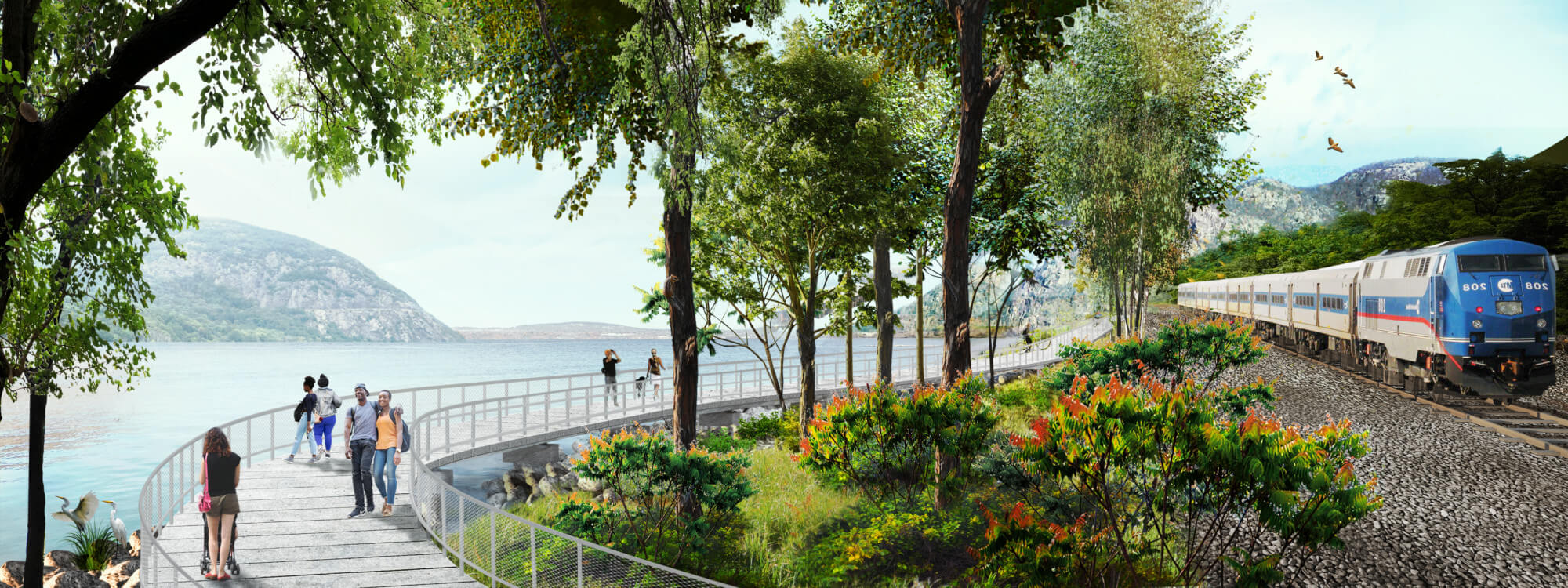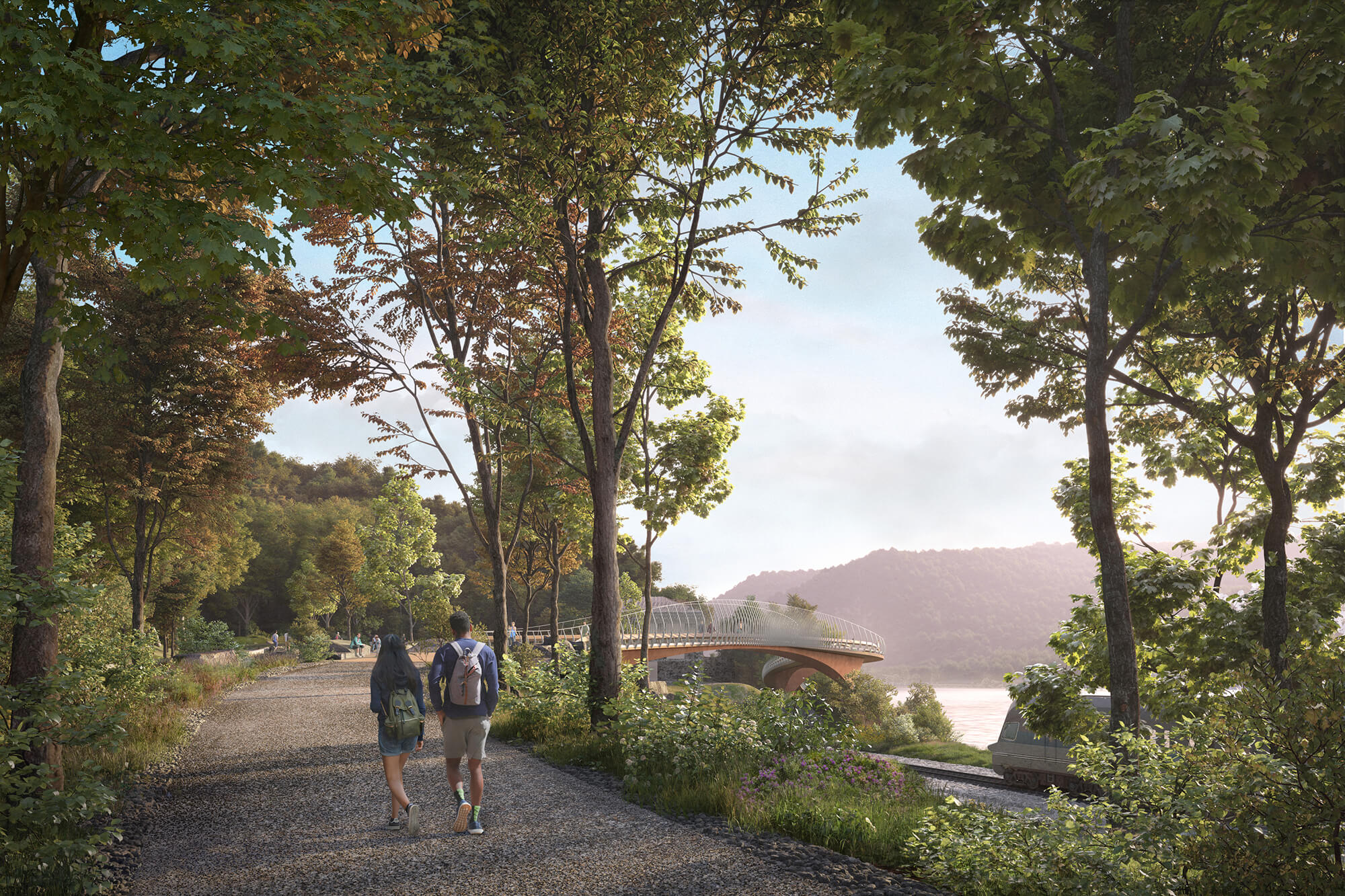A 7.5-mile-long linear park designed by SCAPE seeks to connect Cold Spring and Beacon, New York, with a walking and biking path along the Hudson River. The future Hudson Highlands Fjord Trail is just across from Storm King State Park. At the river bend, SCAPE has designed a linear path with six points of entry to the main trail.
Kate Orff, SCAPE’s founder, said Hudson Highlands Fjord Trail is emblematic of what she calls “people-first” design. Today, SCAPE works with local nonprofits Hudson Highlands Fjord Trail (HHFT) and Philipstown Advocates for Trails (PAT) to bring the project across the finish line.
While SCAPE and the nonprofits shepherding the project, HHFT and PAT, champion the effort, the proposed plan has drawn criticism from local residents. Hudson Highlands Fjord Trail has been in the making for almost two decades, and has been steered by a broad coalition of stakeholders. However some locals worry that Beacon and Cold Spring have become overrun by tourism in recent years, and fear that the new trail may exacerbate the problem.

A local group called Protect the Highlands (PTH) has since formed in opposition to the Hudson Highlands Fjord Trail. PTH argues that what started 15 years ago as a grass roots initiative to improve access to the shoreline has been usurped by a “wealthy donor with a grandiose vision.”
Hudson Highlands Fjord Trail is a capital project that is being financed by private family foundations with additional support from private donors and grants from the state of New York. The nonprofit HHFT was founded in 2020, and has since raised $50 million for the project. Much of the support has come from Christopher Davis, a mutual fund manager who owns a bevy of franchises in the area, including a restaurant, golf course, and events venue. Davis is also the benefactor who donated his land for Hudson Valley Shakespeare Festival to expand, a master plan by Nelson Byrd Woltz Landscape Architects with architecture by Studio Gang.
Metro-North Rail Road is also a key partner in the project. For over a century, the Hudson River shoreline has been largely cut off to locals by Metro-North’s Hudson Valley Line. Hudson Highlands Fjord Trail would restore that connection for the people of Cold Spring, Beacon, and tourists.
The proposed site has four distinct ecologies that SCAPE tries to amplify in its landscape design: River’s Edge, Highlands, Forest, and Marsh. Thus, the 7.5-mile trail is divided into four zones dedicated to each theme. River’s Edge is the trail’s southern most point in Cold Spring. There, Cold Spring’s Dockside Park and Breakneck Ridge will have new direct access to the shoreline, access that was cut off over 100 years ago when the rail line was first built.

Zone two is called the Highlands, an area that refers to the rocky Breakneck Ridge area. This zone has steep topographical changes that provide great views of the Hudson River down below. There, the trail is improving accessibility to better connect hikers to the Ridge’s apex with a project they call Phase One: Breakneck Connector and Bridge.
The third zone is the trail’s most forested area. There, visitors will have a more secluded, immersive experience underneath verdant tree canopies. Then in the fourth, northern-most zone, tributary marshlands of the Fishkill Creek near Beacon and Dennings Points will have elevated paths that allow guests to fully immerse themselves in marsh ecology.
Hudson Highlands Fjord Trail, HHFT said, is designed for inclusivity. SCAPE’s master plan carefully follows Accessibility Guidelines for Federal Outdoor Developed Areas (AGODA) and the Americans with Disabilities Act (ADA), they emphasized.
Most slopes on the trail are at 5 percent or lower, and the trails themselves are typically between 10 and 14 feet wide. (The minimum trail width is 36 inches, the required ADA turning space.) Trail surfaces made of crushed stone are designed for easy usage for visually impaired users, and the trail’s ground material is sized to meet AGODA standards to accommodate people in wheelchairs, among other assistive devices. Moreover, every restroom and kayak launch area on site will be ADA compliant.

Since the 1990s, Breakneck Ridge has attracted hikers en masse to the area. Today, the Ridge draws over 200,000 annual hikers. Moreover, the access road leading up to Breakneck Ridge, State Route 9D, is poorly equipped to handle such volume, and puts pedestrians at risk. This, atop Cold Spring’s attractive Main Street, lined with mom-and-pop restaurants and boutique stores, has inundated the area with daytrippers; a problem many believe the Fjord Trail would add to. Disputes between nonprofit HHFT and those in opposition to the project have been well-chronicled in recent years by myriad local outlets, including Chronogram Magazine, Poughkeepsie Journal, Times Union, and others.
To alleviate concerns related to pedestrian and vehicle traffic, SCAPE’s design would disperse trail visitors across six different points, as opposed to one. HHFT has also assured the public that it will closely maintain the site, and provide bathrooms, wayfinding signage, garbage collection services, and new parking areas.
Gena Wirth, a design principal at SCAPE told Chronogram: “It’s not about creating a shiny object or trying to artificially frame the landscape and create Instagram moments,” she said. “It’s about opening up this state park for a wider swath than the incredibly capable people who can hike Breakneck. And it’s about magnifying the power and the beauty of the landscape and creating a place that people want to appreciate and steward over time.”
HHFT, SCAPE, and engineering consultant Arup continue to regularly host information and review sessions with the community and local stakeholders to discuss the project.
Fjord Trail is slated for completion in 2031.
Correction: A previous version of this article incorrectly stated that the trail will have a play area, swimming area, and an outdoor classroom at Little Stony Point. These were originally planned for the project, but have since been removed from the design. The article was amended on March 9, 2024 to reflect this change. The amended version also included Philipstown Advocates for Trails’ contribution to the Fjord Trail. The updated version also included the projected completion date.
Correction: A previous version of this article stated Studio Gang designed the master plan for Hudson Valley Shakespeare Festival. The article was amended on March 15 to correctly say that Nelson Byrd Woltz Landscape Architects designed the master plan, which features architecture by Studio Gang.











